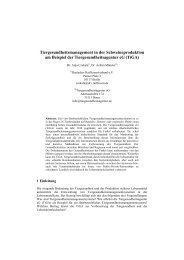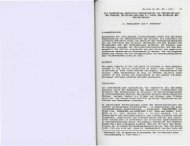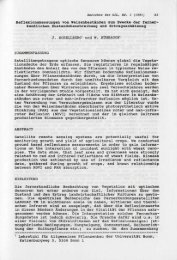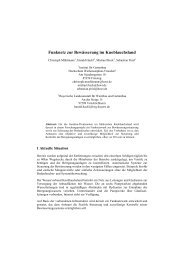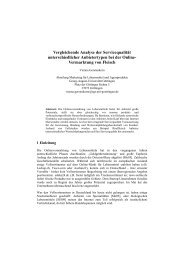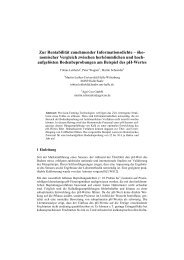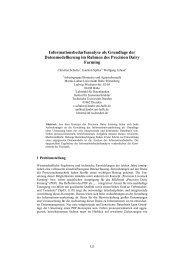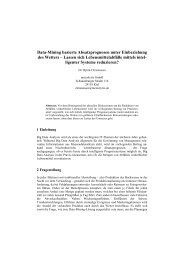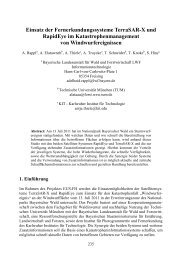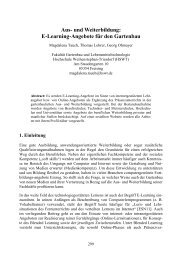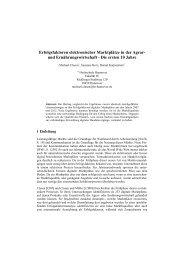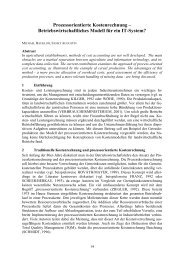Model-based approach to quantify and regionalize peanut ...
Model-based approach to quantify and regionalize peanut ...
Model-based approach to quantify and regionalize peanut ...
You also want an ePaper? Increase the reach of your titles
YUMPU automatically turns print PDFs into web optimized ePapers that Google loves.
<strong>Model</strong>-<strong>based</strong> <strong>approach</strong> <strong>to</strong> <strong>quantify</strong> <strong>and</strong> <strong>regionalize</strong> <strong>peanut</strong><br />
production in the major <strong>peanut</strong> production provinces in the<br />
People’s Republic of China<br />
Heike Knörzer, Simone Graeff-Hönninger, Wilhelm Claupein<br />
Institut für Pflanzenbau und Grünl<strong>and</strong><br />
Universität Hohenheim<br />
Fruwirthstrasse 23<br />
70593 Stuttgart<br />
knoerzer@uni-hohenheim.de<br />
graeff@uni-hohenheim.de<br />
Abstract: China is the largest <strong>peanut</strong> producer in the world <strong>and</strong> <strong>peanut</strong> therefore<br />
an essential economic product earning significant income for China’s farmers.<br />
Major provinces for <strong>peanut</strong> production are located in the middle <strong>and</strong> eastern<br />
provinces. In these regions, drought stress between germination <strong>and</strong> pod setting,<br />
could be severe <strong>and</strong> yield decline because of uneven rainfall <strong>and</strong> climate<br />
variability. Four provinces were selected for modeling <strong>and</strong> simulating large area<br />
yield estimation in order <strong>to</strong> evaluate potential yield with respect <strong>to</strong> average rainfall<br />
in the individual regions. Measured, average yield during the evaluated years<br />
ranged from 2918 kg ha -1 <strong>to</strong> 3969 kg ha -1 with a mean yield of 3420 kg ha -1 <strong>and</strong> a<br />
mean modeled yield of 3422 kg ha -1 . The model showed a good fit between<br />
observed <strong>and</strong> simulated data with a RMSE of 252. <strong>Model</strong> error was 7.4 %.<br />
1 Introduction<br />
Concerning <strong>peanut</strong> <strong>and</strong> <strong>peanut</strong> production, China speaks in superlatives. With more than<br />
290 000 t shelled <strong>and</strong> unshelled <strong>peanut</strong>s in 2007, the country is the largest <strong>peanut</strong><br />
exporter in the world according <strong>to</strong> the FAO with one third of the world market share<br />
[Ch09]. China has one fifths of the world area under <strong>peanut</strong> <strong>and</strong> it produces more than<br />
two fifths of the <strong>to</strong>tal world <strong>peanut</strong> production [Ga04]. In addition, <strong>peanut</strong> is the major<br />
oilseed crop in China making 40 % of the l<strong>and</strong>’s <strong>to</strong>tal oilseed production <strong>and</strong> 25 % of the<br />
cropped area [Ga96]. Hence, <strong>peanut</strong> is an essential economic product for the country.<br />
Since the foundation of the PR China, more than 200 varieties have been bred <strong>and</strong> more<br />
than 80 have been introduced <strong>and</strong> used [Ga96] showing the importance of the crop.<br />
Approximately 70 % of the production takes place in five provinces [Ga04] with<br />
Sh<strong>and</strong>ong, Henan <strong>and</strong> Hebei on <strong>to</strong>p. Seven agro ecological zones are determined with<br />
<strong>peanut</strong> production predominant in the Chinese middle <strong>and</strong> eastern provinces. Highest<br />
yields <strong>and</strong> the largest area under <strong>peanut</strong> production are achieved in Sh<strong>and</strong>ong <strong>and</strong> Henan<br />
province, both part of the North China Plain.<br />
101
Generally one crop or three crops per two years are grown in these regions with <strong>peanut</strong><br />
usually being intercropped with wheat, maize, bean or sweet pota<strong>to</strong>. Since the 1980’s,<br />
when improved management practices like the polythene mulching <strong>and</strong> improved<br />
varieties have been introduced, <strong>peanut</strong> yield increased steadily [Ga04] [Ga96].<br />
Nevertheless, there are constraints about substantial yield gaps [JN96] between yields<br />
realized by farmers <strong>and</strong> those recorded from research stations or potential yield<br />
estimations. Yield fluctuates strongly due <strong>to</strong> climate variation <strong>and</strong> uneven adoption of<br />
improved technology [Ga04]. The objectives of the study were <strong>to</strong> <strong>quantify</strong> the<br />
production potential of <strong>peanut</strong> in Anhui, Hebei, Henan <strong>and</strong> Sh<strong>and</strong>ong provinces with<br />
special regard <strong>to</strong> water dem<strong>and</strong> during the growing season. Water deficit is a major<br />
constrain in <strong>peanut</strong> production [Ri08], especially during the critical period of pod set<br />
which results in reduced pegging. An expert discussion at an international workshop<br />
about situation <strong>and</strong> prospects for groundnut production in China (1996) ranked drought<br />
stress on <strong>to</strong>p of the major constraints for <strong>peanut</strong> production, ahead of acid soils, pests<br />
<strong>and</strong> diseases <strong>and</strong> cold temperature. For that purpose, the Decision Support System for<br />
Agrotechnology Transfer (DSSAT) [Jo03] crop growth model Vs. 4.5 was evaluated <strong>and</strong><br />
validated using five years of yield data from the different provinces. Scenarios were<br />
driven using average weather data from 1976-2005 <strong>and</strong> eleven meteorological stations<br />
across the North China Plain.<br />
2 Materials <strong>and</strong> methods<br />
Within the DSSAT crop growth model, CROPGRO-Peanut is a generic grain legume<br />
model that computes crop growth processes including phenology, pho<strong>to</strong>synthesis, plant<br />
nitrogen, carbon dem<strong>and</strong>, <strong>and</strong> growth partitioning. In addition, the plant development<br />
<strong>and</strong> growth module is linked <strong>to</strong> soil-plant-atmosphere modules. Hence, the model has the<br />
potential for large area yield estimation by input of soil <strong>and</strong> daily weather data [Ga06].<br />
For evaluation <strong>and</strong> validation of the CROPGRO-Peanut model, weather data from local<br />
weather stations of each province was taken [Bi08] [Ch07]. Physical properties of the<br />
provincial predominant soil texture classes [Xi86] silt (Anhui, Hebei, Henan) <strong>and</strong> s<strong>and</strong>y<br />
loam (Sh<strong>and</strong>ong) were derived from [Ch97], [Bö04], <strong>and</strong> [Bi08]. Average yield from<br />
Anhui, Hebei, Henan <strong>and</strong> Sh<strong>and</strong>ong provinces were taken using data from [Ch01]. A<br />
cross validation was done for Anhui for the years 2001/02/04/05, for Sh<strong>and</strong>ong for the<br />
years 2001/02/03/04, for Hebei for the years 2001/02/03/04/05 <strong>and</strong> for Henan for the<br />
years 2002/04/05 using the pre-evaluated DSSAT cultivar ‘Chinese TMV2 TAM’<br />
(Nongshen type) for Anhui, Hebei <strong>and</strong> Henan <strong>and</strong> the ‘Florigiant new’ (Virginia type)<br />
for Sh<strong>and</strong>ong as initial point. According <strong>to</strong> the cross validation, the cultivars’<br />
coefficients were slightly modified for the four provinces. An average plant density of 40<br />
plants m -1 within a hill planting system was used, taking the polythene mulching practice<br />
in<strong>to</strong> account. As <strong>peanut</strong> is a leguminous plant, a balanced fertilization of 20 kg N ha -1 at<br />
sowing was applied for model evaluation. For each province, yield potential was<br />
simulated for average daily incoming solar radiation, minimum temperature, maximum<br />
temperature <strong>and</strong> rainfall using eleven meteorological weather stations’ data.<br />
Subsequently, irrigated <strong>and</strong> rainfed scenarios within a sensitivity analysis were driven in<br />
order <strong>to</strong> detect whether long-term average rainfall could meet the water dem<strong>and</strong>.<br />
102
3 Results <strong>and</strong> discussion<br />
The model showed a good fit between observed <strong>and</strong> simulated yield after the cross<br />
evaluation <strong>and</strong> validation procedure (Fig. 1). Mean observed yield of Anhui was 3625 kg<br />
ha -1 , mean simulated yield 3640 kg ha -1 with a RMSE of 300 (model error = 8.3 %).<br />
Mean observed yield for Hebei was 3028 kg ha -1 , mean simulated yield 3030 with a<br />
RMSE of 315 (model error = 10.4 %). For Henan, mean observed yield was 3410 kg ha -1<br />
<strong>and</strong> mean simulated yield 3391 with a RMSE of 46 (model error = 1.4 %). Mean<br />
observed yield in Sh<strong>and</strong>ong was 3713 kg ha -1 , mean simulated yield 3718 kg ha -1 with a<br />
RMSE of 196 (model error = 5.3 %). Overall cross validation had a RMSE of 252<br />
(model error = 7.37 %). Mean observed yield of all provinces was 3420 kg ha -1 , mean<br />
simulated yield 3422 kg ha -1 . For each province, three simulation scenarios were chosen:<br />
1.) 20 kg N ha -1 at sowing with supplement irrigation; 2.) 20 kg N ha -1 at sowing,<br />
rainfed; 3.) neither nitrogen nor water stress. The results are shown in Table 1:<br />
Yield (kg/ha) (obs.)<br />
5000<br />
4000<br />
3000<br />
2000<br />
Figure 1: Mean observed <strong>peanut</strong> yield of<br />
Anhui, Hebei, Henan <strong>and</strong> Sh<strong>and</strong>ong<br />
provinces versus mean simulated yield<br />
after cross evaluation <strong>and</strong> validation of<br />
the CROPGRO-Peanut model.<br />
1000<br />
0<br />
0 1000 2000 3000 4000 5000<br />
Yield (kg/ha) (sim.)<br />
Table 1: Simulated <strong>peanut</strong> yield of Anhui, Hebei, Henan <strong>and</strong> Sh<strong>and</strong>ong provinces using average<br />
weather data from 1976-2005 <strong>and</strong> three different scenarios.<br />
Anhui Hebei Henan Sh<strong>and</strong>ong<br />
Scenario Yield (kg ha -1 ) Yield (kg ha -1 ) Yield (kg ha -1 ) Yield (kg ha -1 )<br />
20 kg N ha -1 , irrigated 3848 3216 3877 4485<br />
20 kg N ha -1 , rainfed 3848 3254 3914 2746<br />
no N/water stress 3903 3244 3927 4482<br />
As reported, <strong>peanut</strong> is very susceptible for water deficit. In the North China Plain, 50-<br />
75 % of the <strong>to</strong>tal rainfall occurs between July <strong>and</strong> September. In most years, the amount<br />
of rainfall is enough <strong>to</strong> satisfy the dem<strong>and</strong>. Water shortage may occur at the beginning of<br />
the growing season of <strong>peanut</strong> as <strong>peanut</strong> is generally sown between mid of April <strong>and</strong> mid<br />
of May in these regions, <strong>and</strong> may last until the critical phase of pod setting around 50<br />
days after sowing. The simulation showed that for Anhui <strong>and</strong> Henan, the long-term<br />
average rainfall met the dem<strong>and</strong> of <strong>peanut</strong>. No supplement irrigation would be needed.<br />
103
In contrast, the average rainfall in Hebei <strong>and</strong> especially in Sh<strong>and</strong>ong was not enough <strong>to</strong><br />
satisfy the dem<strong>and</strong>. Without irrigation, <strong>peanut</strong> yield decreased notable in Sh<strong>and</strong>ong.<br />
Sh<strong>and</strong>ong is the most important <strong>peanut</strong> region in China [Ch09] [Ga04] with the highest<br />
yield potential. The s<strong>and</strong>y soils predominant in Sh<strong>and</strong>ong were more likely <strong>to</strong> desiccate<br />
than the silty soils in the other provinces. [Ri08] reported from Argentina, that water<br />
stress promoted a significant decline up <strong>to</strong> 73 % in <strong>peanut</strong> seed yield because of reduced<br />
seed <strong>and</strong> pod numbers. Accordingly, a notable reduction in pod number for Sh<strong>and</strong>ong<br />
was simulated by the model. The CROPGRO-Peanut model was able <strong>to</strong> simulate <strong>and</strong><br />
estimate large area yield for the four major <strong>peanut</strong> producing provinces in China. To<br />
study the potential yield of <strong>peanut</strong> with special regard <strong>to</strong> water dem<strong>and</strong>, the <strong>approach</strong><br />
was useful comparing possible lacks in dem<strong>and</strong> with average rainfall. Further on, the<br />
model setting could be used for additional scenario <strong>and</strong> sensitivity analysis 1 .<br />
References<br />
[Bi08] Binder, J. et al.: <strong>Model</strong> <strong>approach</strong> <strong>to</strong> <strong>quantify</strong> production potentials of summer maize <strong>and</strong><br />
spring maize in the North China Plain. In: Agronomy Journal 100, 2008, p. 862-873.<br />
[Bö04] Böning-Zilkens, M.I: Comparative appraisal of different agronomic strategies in a winter<br />
wheat-summer maize double cropping system in the North China Plain with regard <strong>to</strong><br />
their contribution <strong>to</strong> sustainability. Diss. Universität Hohenheim, Aachen, 2004.<br />
[Ch09] Chen, C. et al.: Competitiveness of <strong>peanut</strong>s: United States versus China. The University<br />
of Georgia, Cooperative Extension, Research Bulletin 430, 2009.<br />
[Ch07] China Meteorological Administration: Weather data. Beijing, 2007.<br />
[Ch01] China Provincial Statistical Yearbooks, All China Data Center, University of Michigan,<br />
2001-2005.<br />
[Ch97] Chinese Academy of Science: Chinese soil survey 1997. Beijing, 1997.<br />
[Ga96] Gai, S. et al.: Present situation <strong>and</strong> prospects for groundnut production in China. In:<br />
Achieving high groundnut yields (Gowda, C.L.L., Nigam, S.N., Johansen, C. <strong>and</strong><br />
Renard, C., Ed.), India, 1996, p. 17-26.<br />
[Ga04] Gang, Y.: Peanut production <strong>and</strong> utilization in the People’s Republic of China. In:<br />
Peanut in local <strong>and</strong> global food systems series report no. 4 (Rhoades, R.E., Ed.),<br />
University of Georgia, 2004.<br />
[Ga06] Garcia, G.Y. et al.: Analysis of the inter-annual variation of <strong>peanut</strong> yield in Georgia<br />
using a dynamic crop simulation model. In: Transactions of the ASABE 49, 2006, p.<br />
2005-2015.<br />
[JN06] Johansen, C., Nageswara Rao, R.C.: Maximizing groundnut yield. In: Achieving high<br />
groundnut yields (Gowda, C.L.L., Nigam, S.N., Johansen, C. <strong>and</strong> Renard, C., Ed.), India,<br />
1996, p. 117-127.<br />
[Jo03] Jones, J.W. et al.: The DSSAT cropping system model. In: European Journal of<br />
Agronomy 18, 2003, p. 235-265.<br />
[Ri08] Ricardo, J.H. et al.: Seed yield determination of <strong>peanut</strong> crops under water deficit: soil<br />
strength effects on pod set, the source-sink ratio <strong>and</strong> radiation use efficiency. In: Field<br />
Crops Research 109, 2008, p 24-33.<br />
[Xi89] Xi, Y. (Ed.): Atlas of the People’s Republic of China. 1 st ed., Foreign Language Press,<br />
China Car<strong>to</strong>graphic Pub. House, Beijing, 1989.<br />
1 We thank the German Research Foundation (DFG) <strong>and</strong> the Ministry of Education (MOE) of the People’s<br />
Republic of China for financial support (GRK 1070).<br />
104



